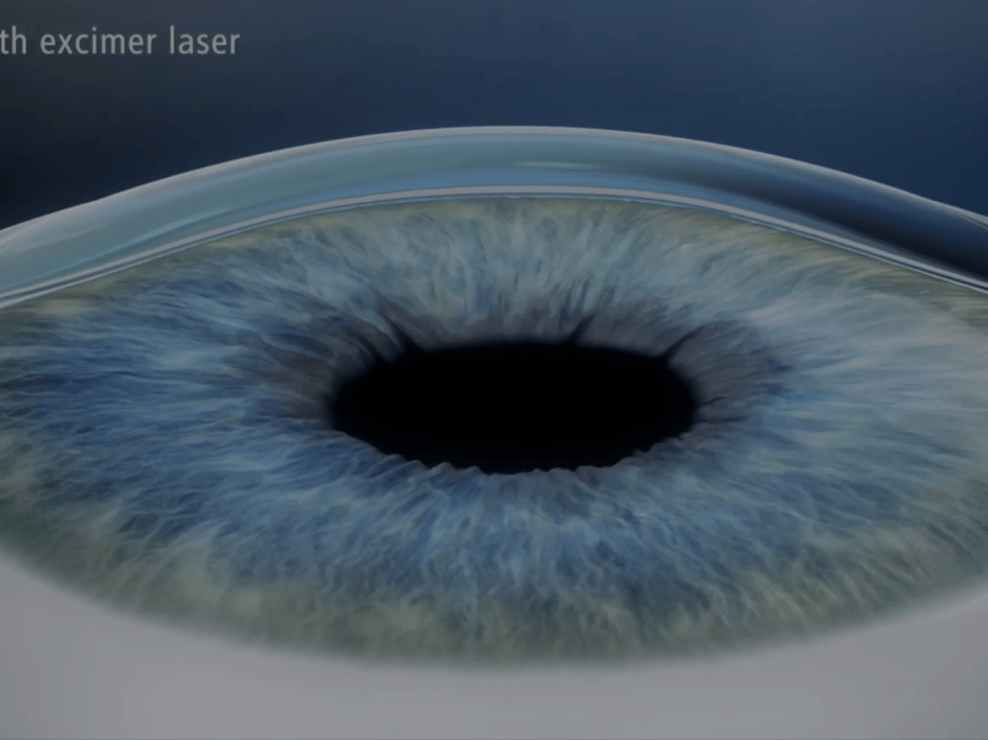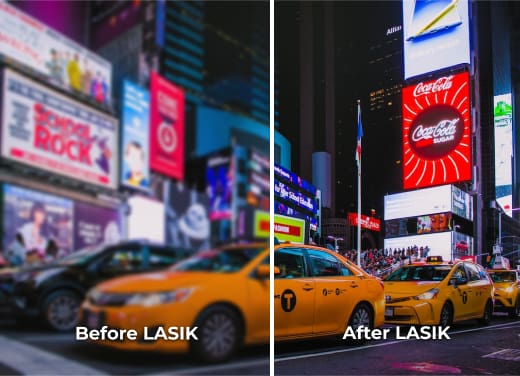LASIK Eye Surgery
LASIK eye surgery is a safe and highly effective way to correct vision and say goodbye to glasses and contacts. NVISION’s experienced eye surgeons use state-of-the-art technology and modern techniques to get you back to your routine in no time.

99% Success Rate
99% of NVISION patients get 20/20 vision or better
24-hour Recovery
Get back to your normal routine within a day
Safe & Effective
The LASIK procedure lasts just 10 minutes
Save Thousands
Break free from the yearly costs of glasses and contacts
Table of Contents
What Is LASIK eye surgery?
LASIK, or Laser-Assisted In Situ Keratomileusis, is a transformative, minimally invasive procedure designed to reshape the cornea — the clear front part of your eye — to correct common vision problems like myopia (nearsightedness), hyperopia (farsightedness), and astigmatism. With this procedure, you’ll no longer have to depend on glasses or contacts for clear vision.
At NVISION, we offer top-tier LASIK eye surgery characterized by precision, safety, and convenience. Within a mere 10 minutes, you can step out of our advanced surgical suites, leave behind the hassle of corrective eyewear, and step into a world seen with newfound clarity. Experience the liberating power of 20/20 vision, or even better, and uncover the potential for a life less encumbered by the limitations of visual impairment.
How Much Is LASIK eye surgery?
Understanding the cost of LASIK eye surgery is an important part of making your decision. The price can fluctuate based on several factors, including the complexity of the individual’s case, the level of technology used, and the expertise of the surgeon performing the procedure.
NVISION’s pricing is competitive, falling well within the usual local ranges, while providing unique advantages. These include cutting-edge technology, top-tier surgeons, and our exceptional ‘Vision for Life’ free enhancements plan.
It’s essential to consider the long-term financial benefits of LASIK as well. Many people find that the procedure saves them tens of thousands of dollars over their lifetime by eliminating the recurring costs of glasses or contacts.
Learn More: How Much Does LASIK Cost?
Is LASIK eye surgery Safe? What Makes It So Safe?
LASIK stands as one of the safest and most studied procedures in all of medicine, backed by decades of application and a multitude of clinical trials. It’s a testament to this safety that LASIK surgeons themselves are five times more likely to have undergone the procedure than the general population, with 98% of them even trusting the procedure for their own family members.
In fact, LASIK’s safety record surpasses that of long-term contact lens wear. Over the years, contact lens use can increase the likelihood of developing dry eyes, and every insertion presents a new chance for potential infection.
How Effective is LASIK eye surgery?
LASIK eye surgery stands as a testament to the pinnacle of vision correction technology. With our focus on precision and quality care, we’ve achieved an impressive success rate at NVISION.
In fact, 99% of our patients have achieved 20/20 vision or better following the procedure. This high success rate underscores the effectiveness of LASIK as a fast, reliable, and transformative solution to common vision problems.
How long does LASIK eye surgery last?
The effectiveness of LASIK eye surgery in terms of vision correction is typically long-lasting. Many people experience a significant improvement in their vision immediately after the procedure, and the benefits can be permanent. However, it’s important to note that individual responses to LASIK can vary.
While LASIK can provide lasting results, factors such as age-related changes in vision (presbyopia), the progression of certain eye conditions, and other health factors can affect vision over time. Additionally, some individuals may experience changes in their vision that require LASIK enhancements or adjustments after the initial LASIK procedure.
Regular eye check-ups are essential to monitor the stability of your vision and address any changes that may occur. It’s also crucial to follow post-operative care instructions provided by your eye care professional to optimize the healing process and ensure the best possible outcomes.


“I am blown away by how incredible my vision is!”
Firefighter & LASIK Patient

“It was really fast! I got up, went home to rest and then... I could see!”
Tour Guide & LASIK Patient

“My vision is definitely the best its ever been. So, I am super happy with the results!”
Sailing Enthusiast & LASIK Patient
What to Expect with LASIK Eye Surgery
At NVISION, your LASIK journey is designed to be smooth, supportive, and life-changing. It all starts with a comprehensive evaluation to confirm you’re a good candidate. On procedure day, expect a quick, comfortable treatment—typically just minutes per eye. Afterward, our expert team provides clear guidance and personalized aftercare to ensure a fast recovery and outstanding results. From start to finish, we’re here to make your experience simple, safe, and stress-free.

Free in-depth consultation
Our experienced team will conduct a comprehensive eye exam to determine if LASIK is a good option for you
Fast and painless procedure
LASIK is fast and painless - the procedure only takes about 10 minutes

Resume your normal activities
LASIK recovery is fast – most patients get back to their normal routine in just 24 hours
From scheduling your free consultation to understanding the aftercare process, NVISION is committed to making sure you feel prepared and confident about your decision. Click on the sections below to learn more about each stage of your LASIK experience.
Scheduling a Free Consultation
The first step towards your vision transformation journey is scheduling a free LASIK consultation. In this session, the experienced NVISION team will conduct a comprehensive eye exam and discuss your vision goals. This is your opportunity to ask any questions you may have about the procedure or our facilities.
Learn More: Schedule a Free Consultation with NVISION
Preparing for Surgery
Once deemed a suitable candidate for LASIK, you’ll be guided through the necessary steps to prepare for your procedure. This includes simple instructions related to your eye health, such as discontinuing contact lens usage for a specified period and avoiding eye makeup or creams on the day of surgery. The NVISION team will be there to support and advise you during this preparation phase.
Procedure
On the day of the procedure, expect to spend about a half hour at the facility. The LASIK surgery itself is swift, taking only around 10 minutes. During this time, state-of-the-art laser technology is used to reshape your cornea, correcting your vision. It’s a painless process, with numbing drops applied to your eyes to ensure comfort throughout.
Learn More: How Does LASIK Work?
Recovery & Post-Op Care
Post-procedure, you’ll rest briefly in our recovery room before going home. The healing process begins immediately, and many patients notice an improvement in their vision within a few hours. Most patients are able to return to their normal activities the next day. Nvision will provide comprehensive post-op care instructions and arrange follow-up appointments to monitor your progress.
Learn More: LASIK Recovery Time & What to Expect
Aftercare
Your care doesn’t stop when the procedure is over. NVISION takes aftercare seriously and is committed to ensuring your recovery is smooth and your results are long-lasting. Regular follow-up appointments are part of this LASIK post-operative care process, allowing the team to track your healing progress and vision improvement.
Am I a Candidate for LASIK?
Determining candidacy for LASIK eye surgery is a crucial initial step. Generally, ideal candidates are at least 18 years old, have had a stable prescription for at least one year, and are in good general health without serious eye conditions. However, this doesn’t paint the full picture — individual vision profiles and lifestyle needs play a significant role in determining candidacy.
Importantly, at NVISION, we leverage advanced technology and innovative techniques that may qualify individuals who have been previously deemed unsuitable for LASIK at other centers. This is why a comprehensive consultation with us is crucial. It’s our goal to explore all possibilities to help you achieve better vision.
Conditions LASIK Can Treat
Astigmatism
Astigmatism occurs when the cornea has an irregular shape, causing blurred or distorted vision. LASIK effectively treats astigmatism by reshaping the cornea to correct the uneven curvature. The result is clearer, sharper vision that can eliminate or reduce the need for corrective eyewear.
Learn More: Getting LASIK for Astigmatism
Farsightedness
People who are farsighted have difficulty focusing on nearby objects, while distant objects are typically clear. This is often due to the eye being too short or the cornea too flat. With LASIK, surgeons can adjust the shape of the cornea, increasing its curvature to enhance the eye’s ability to focus on nearby objects.
Nearsightedness
Nearsightedness (myopia) results in clear vision for close objects but blurry vision for distant objects, typically caused by an overly long eye or overly curved cornea. LASIK corrects myopia by flattening the cornea, allowing light entering the eye to focus correctly on the retina to improve distant vision.
Learn More: Getting LASIK for Nearsightedness
Making LASIK More Affordable
Thanks to the convenient financing options at NVISION, it’s easier than ever to get the great vision you deserve. Explore our LASIK financing options today!

Your Nearest Center
NVISION - Folsom Hines Eye & Laser
916-222-3523 50 Iron Point Circle, Suite #130Folsom, CA 95630

Insurance & Discounts
Is LASIK Covered by Insurance?
LASIK eye surgery is typically considered an elective procedure and not medically necessary, which means it is typically not covered by insurance. However, some providers may offer discounts or special rates for LASIK, depending on the specifics of your plan. It’s always a good idea to check with your insurance provider to understand the benefits available to you.
VSP and LASIK
NVISION stands out as a partner of VSP, offering substantial benefits to VSP members that are rarely matched elsewhere. Through this collaboration with VSP, NVISION frequently provides exclusive VSP discounts on LASIK procedures – including offers of at least $1,000 off! – making the transformative journey towards clearer vision more accessible and affordable.
Frequently Asked Questions About LASIK
Does LASIK Wear Off?
No, LASIK permanently reshapes your cornea. However, changes related to age may occur. With NVISION’s Lifetime Commitment, you can rest assured that any future enhancements will be done at no additional cost.
Can You Get LASIK in Both Eyes?
Yes, most patients opt to have LASIK in both eyes during the same appointment for convenience and balanced vision. Having LASIK in both eyes may lead to better post-op outcomes.
Are There Age Limits to LASIK?
Yes, LASIK is FDA-approved for individuals who are 18 years and older. However, most people typically undergo LASIK between the ages of 20 and 40. Age-related factors are considered on a case-by-case basis.
When Can You Return to Normal Activities?
Most LASIK patients can resume normal activities within 24 hours post-surgery, but you should avoid strenuous activity until cleared by your doctor. Follow your doctor’s instructions carefully to ensure a smooth recovery process.
Other Frequently Asked Questions
Do You Offer Financing?
LASIK financing options are available with NVISION to make LASIK even more attainable. For example, No Interest if Paid in Full within 24 Months‡ on qualifying purchases of $200 or more with your CareCredit credit card. Interest will be charged to your account from the purchase date if the promotional balance is not paid in full within 24 months. Minimum monthly payments required.
Learn More: Financing LASIK With NVISION
What Does LASIK Feel Like?
During LASIK, patients typically feel slight pressure but no pain thanks to numbing eye drops. It’s common to experience some minor discomfort in the hours following surgery. Many patients get through this with a simple nap.
Learn More: What Does LASIK Feel Like?
Are There Alternatives to LASIK?
Alternatives to LASIK include procedures like PRK, SMILE, and lens implants. The best procedure for you depends on your individual eye health and needs.
What Are The Side Effects of LASIK?
Common temporary side effects of LASIK include dry eyes, glare, halos around lights, and light sensitivity. Severe complications are rare, and most side effects usually resolve within weeks to months.
Does VSP Vision Insurance Cover LASIK?
Some VSP plans may offer partial coverage or discounts for LASIK. It’s best to check with your VSP representative or our office for details pertaining to your specific plan.
Learn More: VSP Coverage for LASIK
What Are The Different Types of LASIK?
There are several types of LASIK procedures including bladeless or bladed LASIK. Each type has its own benefits, and the best choice depends on the patient’s individual needs and eye health. At NVISION, we employ the most up-to-date technology, ensuring a world-class experience with the precision and care you deserve.
Why Choose NVISION for LASIK?
Unmatched Experience
Our board-certified surgeons have completed over 2.5 million procedures, using the latest technology and unmatched expertise to give each patient the best possible care.
Leading-Edge Technology
At NVISION, we deliver exceptional care with advanced technologies like Contoura®, which maps 22,000 points on the cornea for precise, personalized treatment plans. Thanks to our advanced technology, our experienced surgeons deliver an elevated standard of care and outstanding outcomes.
NVISION Lifetime Commitment
Our Lifetime Commitment offers unmatched peace of mind: if a future enhancement is needed to maintain vision results, clinically qualified participating patients will receive a same-technology enhancement procedure, free of charge.

Book Your Consultation
You're one step closer to life without glasses or contacts. Just answer a few quick questions about your eye exam, and we'll lock in your appointment.
Have a question? Give our experts a call!
877-455-9942
Related LASIK Topics
- Pros & Cons of LASIK
- How Many Times Can You Get LASIK?
- Disqualifications for LASIK
- Separating Social Media Myths from Medical Reality
- Vision Requirements for LASIK
- Preventing Pain After LASIK
- LASIK Glare & Halos
- Doctor Difference in LASIK
- LASIK Enhancements
- Common LASIK Myths
- Eyewear After LASIK Surgery
- Does Medicare Pay for LASIK?
- How Many People Get LASIK Surgery Each Year?